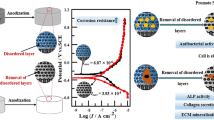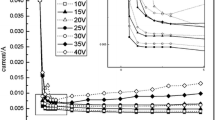Abstract
Followed by well-known AAO templates, anodic titanium oxide (ATO) surface with nanoporous structure has gained extensive attraction as implants due to its excellent surface properties. So, the objective of this work was to explore a novel approach for electroless Ni–P film on nanoporous ATO surface, with an aim to obtain a strong bonding interface between Ti substrate and its surface films. Impressively, with anodizing DC potential extending from 100 to 300 V, a two-step anodizing process was created to achieve nanoporous ATO surface with a suitable diameter size that acted as bonding pinholes for amorphous Ni–P growth. Structural design of electroless Ni–P film onto ATO surface was innovatively addressed for increasing interfacial bonding strength between Ti substrate and its surface film. Regarding the ATO surface with nondestructive characteristics, several pretreatments were processed with anodizing, sensitizing, activating, following by electroless Ni–P film. Among them, Pd-reducing crystal sites, which were capable of effectively adsorbing on ATO surface, were emerged as preferential locations for catalytic growth of Ni–P film to make pinning effects toward ATO nanopores. Results indicated that the well-organized ATO nanoporous arrays were successfully processed onto the surface of Ti substrate through the mixed sulfuric–phosphoric acids electrolyte at DC 210 V. When nanosized Ni–P grains were planted inside nanoporous arrays of ATO surface, it was expected as growing sites to refine the subsequent Ni–P growth and thus resulting in higher compactness of electroless Ni–P film on ATO surface. Further studies of the laser-assisted MAG welding on the as-received ATO surface within electroless Ni–P film were conducted, thereby achieving a superior metallurgical bonding for Ti/Ni–P interface. More important, this was the first attempt to design nanoporous arrays for Ni–P growth on ATO surface to increase its weldability of Ti alloys, also supporting a new guideline for multi-functional films on porous surface of the as-anodized Ti, Mg, and Al alloys.















Similar content being viewed by others
References
Zhang YS, Zhang W, Wang X, Huo WT (2017) Formation of core–shell network structural titanium–nitrogen alloys with different nitrogen contents. J Mater Sci 52(13):7824–7830. doi:10.1007/s10853-017-1015-8
Song JN, Zheng MJ, Yuan XL, Li Q, Wang FZ, Ma LG, You YX, Liu SH, Liu PJ, Jiang DK, Ma L, Shen WZ (2017) Electrochemically induced Ti3+ self-doping of TiO2 nanotube arrays for improved photoelectrochemical water splitting. J Mater Sci 52(12):6976–6986. doi:10.1007/s10853-017-0930-z
Vu THT, Au HT, Tran LT, Nguyen TMT, Tran TTT, Pham MT, Do MH, Nguyen DL (2014) Synthesis of titanium dioxide nanotubes via one-step dynamic hydrothermal process. J Mater Sci 49(16):5617–5625. doi:10.1007/s10853-014-8274-4
Zhou XW, Shen YF (2014) Surface morphologies, tribological properties, and formation mechanism of the Ni–CeO2 nanocrystalline coatings on the modified surface of TA2 substrate. Surf Coat Technol 249:6–18
Shi XL, Xu LL, Munar ML, Ishikawa K (2015) Hydrothermal treatment for TiN as abrasion resistant dental implant coating and its fibroblast response. Mater Sci Eng C Mater 49(49):1–6
Romankov S, Sha W, Kaloshkin SD (2006) Fabrication of TiAl coatings by mechanical alloying method. Surf Coat Technol 201:3235–3245
Albu SP, Schmuki P (2013) Influence of anodization parameters on the expansion factor of TiO2 nanotubes. Electrochim Acta 91:90–95
Liu H, Tang B, Wang L, Wang X (2005) Improvement on surface properties of titanium alloy by plasma immersion ion implantation technique. Rare Met Mater Eng 34(8):1318–1321
Liu LL, Xu J, Munroe P, Xie ZH (2014) Microstructure, mechanical and electrochemical properties of in situ synthesized TiC reinforced Ti5Si3 nanocomposite coatings on Ti–6Al–4V substrates. Electrochim Acta 115:86–95
Yan C, Hao L, Hussein A, Wei Q, Shi Y (2017) Microstructural and surface modifications and hydroxyapatite coating of Ti–6Al–4V triply periodic minimal surface lattices fabricated by selective laser melting. Mater Sci Eng C 75:1515–1524
Chen F, Zhou H, Chen C, Xia YJ (2009) Study on the tribological performance of ceramic coatings on titanium alloy surfaces obtained through microarc oxidation. Prog Org Coat 64(2–3):264–267
Amanov A, Urmanov B, Amanov T, Pyun YS (2017) Strengthening of Ti–6Al–4V alloy by high temperature ultrasonic nanocrystal surface modification technique. Mater Lett 196:198–201
Zhao G, Zhang L, Niu Y, Sun K (2017) A molten Mg corrosion method for preparing porous Ti foam as self-supported Li–O2 battery cathodes. Electrochim Acta 224:64–70
Guo C, Zhou JS, Zhao JR (2011) Microstructure and tribological properties of a HfB2-containing Ni-Based composite coating produced on a pure Ti substrate by laser cladding. Tribol Lett 44:187–200
Li B, Shen YF, Luo L, Hu WY, Zhang ZH (2013) Surface aluminizing on Ti–6Al–4V alloy via a novel multi-pass friction-stir lap welding method: preparation process, oxidation behavior and interlayer evolution. Mater Des 49:647–656
Huang Y, Zhang XJ, Zhao RL, Mao HH, Yan Y, Pang XF (2015) Antibacterial efficacy, corrosion resistance, and cytotoxicity studies of copper-substituted carbonated hydroxyapatite coating on titanium substrate. J Mater Sci 50(4):1688–1700. doi:10.1007/s10853-014-8730-1
Lee H-K, Okada T, Fujiwara T, Lee S-W (2016) Top-down synthesis and deposition of highly porous TiO2 nanoparticles from NH4TiOF3 single crystals on multi-walled carbon nanotubes and graphene oxides. Mater Des 108:269–276
Wang J, Lin Z (2009) Anodic formation of ordered TiO2 nanotube arrays: effects of electrolyte temperature and anodization potential. J Phys Chem C 113(10):4026–4030
Kapusta-Kołodziej J, Syrek K, Pawlika A, Jarosz M, Tynkevych O, Sulka GD (2017) Effects of anodizing potential and temperature on the growth of anodic TiO2 and its photoelectrochemical properties. Appl Surf Sci 396:1119–1129
Chang YJ, Lee JW, Chen HP, Liu LS, Weng GJ (2011) Photocatalytic characteristics of TiO2 nanotubes with different microstructures prepared under different pulse anodizations. Thin Solid Films 519(10):3334–3339
Huang X, Liu Y, Yu H, Yang X, Wang Y, Hang R, Tang B (2016) One-step fabrication of cytocompatible micro/nano-textured surface with TiO2 mesoporous arrays on titanium by high current anodization. Electrochim Acta 199:116–125
Mohammadpour F, Moradi M (2015) Double-layer TiO2 nanotube arrays by two-step anodization: used in back and front-side illuminated dye-sensitized solar cells. Mater Sci Semicond Process 39:255–264
Zhang Y, Cheng W, Du F, Zhang S, Ma W, Li D, Song Y, Zhu X (2015) Quantitative relationship between nanotube length and anodizing current during constant current anodization. Electrochim Acta 180:147–154
Shi XL, Xu LL, Le TB, Zhou GH, Zheng CB, Tsuru K, Ishikawa K (2016) Partial oxidation of TiN coating by hydrothermal treatment and ozone treatment to improve its osteoconductivity. Mater Sci Eng C 59(4):542–548
Jin R, Fan H, Liu Y, Ma W, Lu H, Yang P, Ma W (2016) Formation Mechanism of lotus-root-shaped nanostructure during two-step anodization. Electrochim Acta 188:421–427
Chang C, Huang X, Liu Y, Bai L, Yang X, Hang R, Tang B, Chu P (2015) High-current anodization: a novel strategy to functionalize titanium-based biomaterials. Electrochim Acta 173:345–353
Wang X, Sun L, Zhang S, Wang X (2014) Ultralong, small-diameter TiO2 nanotubes achieved by an optimized two-step anodization for efficient dye-sensitized solar cells. ACS Appl Mater Interfaces 6(3):1361–1365
Zhou XW, Ouyang C (2017) Anodized porous titanium coated with Ni–CeO2 deposits for enhancing surface toughness and wear resistance. Appl Surf Sci 405:476–488
Shibli SMA, Riyas AH, Ameen Sha M, Mole R (2017) Tuning of phosphorus content and electrocatalytic character of CeO2–RuO2 composite incorporated Ni–P coating for hydrogen evolution reaction. J Alloys Compd 696:595–603
Lin LY, Yeh MH, Chen WC, Ramamurthy V, Ho KC (2015) Controlling available active sites of Pt-loaded TiO2 nanotube-imprinted Ti plates for efficient dye-sensitized solar cells. ACS Appl Mater Interfaces 7(7):3910–3919
Oliver WC, Pharr GM (2004) Measurement of hardness and elastic modulus by instrumented indentation: advances in understanding and refinements to methodology. J Mater Res 19(1):3–20
Zwilling V, Darque-Ceretti E, Boutry-Forveille A, David D, Perrin MY, Aucouturier M (1999) Structure and physicochemistry of anodic oxide films on titanium and TA6V alloy. Surf Interface Anal 27(7):629–637
Bessegato GG, Hudari FF, Zanoni MVB (2017) Self-doped TiO2 nanotube electrodes: a powerful tool as a sensor platform for electroanalytical applications. Electrochim Acta 235:527–533
Zhang W, Xi Z, Li G, Wang Q, Tang H, Liu Y (2009) Highly ordered coaxial bimodal nanotube arrays prepared by self-organizing anodization on Ti alloy. Small 5(15):1742–1746
Makkar P, Agarwala RC, Agarwala V (2015) Wear and corrosion characteristics of alumina dispersed Ni–P nanocomposite coating developed by electroless technique. J Mater Sci 50(7):2813–2823. doi:10.1007/s10853-015-8839-x
Wang J, Wu Q (2017) The effects of anodic interlayer on the morphology and mechanical performances of electroless Ni–P coating on Al alloy. Appl Phys A 123(6):435–442
Wu X, Liu Z, Jiang Y, Zeng J, Liao S (2017) Randomly oriented Ni–P/nanofiber/nanotube composite prepared by electrolessly plated nickel-phosphorus alloys for fuel cell applications. J Mater Sci 52(14):1–12. doi:10.1007/s10853-017-1094-6
Farokhzadeh K, Edrisy A, Pigott G, Lidster P (2013) Scratch resistance analysis of plasma-nitrided Ti–6Al–4V alloy. Wear 302(1–2):845–853
Zaraska L, Czopik N, Bobruk M, Sulka GD, Mech J, Jaskuła M (2013) Synthesis of nanoporous tin oxide layers by electrochemical anodization. Electrochim Acta 104:549–557
Ehtemam-Haghighi S, Cao G, Zhang LC (2017) Nanoindentation study of mechanical properties of Ti based alloys with Fe and Ta additions. J Alloys Compd 692:892–897
Diamanti MV, Pedeferri MP (2007) Effect of anodic oxidation parameters on the titanium oxides formation. Corros Sci 49(2):939–948
Guo PY, Zhang J, Young DJ, Honrad CH (2015) Oxygen permeability measurements in Ni using H2/H2O, CO/CO2 and Ni/NiO rhines pack atmospheres. Oxid Met 83(3–4):223–235
Xu L, Wei D, Chen Y, Li R (2016) A feasible electrochemical method for tuning coatings wettability from superhydrophilicity to superhydrophobicity. Appl Surf Sci 385:80–87
Wang Y, Lou J, Zeng L, Xiang J, Zhang S, Wang J, Xiong F, Li C, Zhao Y, Zhang R (2017) Osteogenic potential of a novel microarc oxidized coating formed on Ti–6Al–4V alloys. Appl Surf Sci 412:29–36
Miao L, Lu L, Fu T, Tang Y, Tang B (2015) Experimental investigation on wetting process of water droplets on micro-/nanoporous copper films. Appl Phys A 120(1):255–263
Darmanin T, Taffin de Givenchy E, Amigoni S, Guittard F (2013) Superhydrophobic surfaces by electrochemical processes. Adv Mater 25(10):1378–1394
Zhu L, Luo L, Luo J, Li J, Wu Y (2012) Effect of electroless plating Ni–Cu–P layer on the wettability between cemented carbides and soldering tins. Int J Refract Met Hard Mater 31(3):192–195
Buijnsters JG, Zhong R, Tsyntsaruand N, Celis JP (2013) Surface wettability of macroporous anodized aluminum oxide. ACS Appl Mater Interfaces 5(8):3224–3233
Karolus M, Panek J (2016) Nanostructured Ni–Ti alloys obtained by mechanical synthesis and heat treatment. J Alloys Compd 658:709–715
Acknowledgements
This work was financially supported by the National Natural Science Foundation of China (Grant No. 51605203), Natural Science Foundation of Jiangsu Province (BK20150467), and Doctoral Scientific Research Foundation of Jiangsu University of Science and Technology (1062921501).
Author information
Authors and Affiliations
Corresponding author
Ethics declarations
Conflict of interest
All the authors declare that they have no conflict of interest.
Rights and permissions
About this article
Cite this article
Zhou, X., Wu, F. & Ouyang, C. Electroless Ni–P alloys on nanoporous ATO surface of Ti substrate. J Mater Sci 53, 2812–2829 (2018). https://doi.org/10.1007/s10853-017-1686-1
Received:
Accepted:
Published:
Issue Date:
DOI: https://doi.org/10.1007/s10853-017-1686-1




